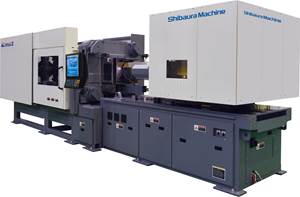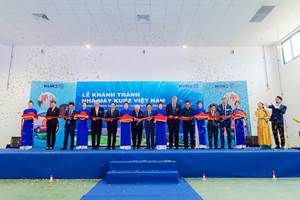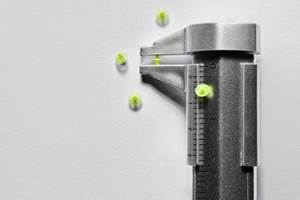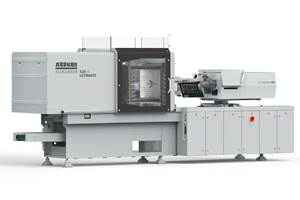Breaking News From NPE2024
Here is a firsthand report of news in injection molding, extrusion, blow molding and recycling not previously covered.
Share
Editor’s Note: More than 50,000 attendees packed the halls of the Orange County Convention Center in Orlando, Florida, May 6-10, for NPE2024, the first NPE since 2018 (NPE2020 was shelved due to the COVID-19 pandemic). Here, we cover developments in the major process segments not previously reported in previous issues of Plastics Technology. Please refer to the February, March, April, May and June issues for pre-show coverage. We will continue our reporting of NPE2024 in August.
Pushing PET to the Limit in Thinwall Packaging Designs
Applying its Thin Recess Injection Molding (TRIM) and other advances, toolmaker StackTeck Systems Ltd., sought to push PET to its limits — and into new areas of packaging — at NPE2024.
StackTeck’s TRIM technology, where application of thinner panels reduce material usage, has been demonstrated to lightweight conventional thinwall designs by 10% to 40% of part weight. Applying TRIM panels all over the part can compromise container strength, so StackTeck has conceived of an alternative approach that applies TRIM to the bottom only, leaving alone the sidewall and corner wall thicknesses. In this way, top-load performance and other performance criteria are met but 5% light weighting can still be achieved.
In cooperation with injection molding machine supplier Netstal, StackTeck introduced a transparent, thin-walled PET container, seeking to displace polyolefins normally applied for such packaging. Using a 1 × 2 TRIM multigated tool, the 350-ton Elion machine applied

In cooperation with machine builder Netstal, StackTech showed a transparent, thin-wall PET containers that aims to displace polyolefins normally used for such applications. Source: StackTec
inmold-labeling (IML) of a thin PET label to create a 450-ml IML container weighing only 15 g in a 4-second cycle. The system also utilized a StackTeck IML Robot, vision and stacking system.
Jordan Robertson, vice president of business development & marketing at StackTeck, told Plastics Technology that the tool utilized sequential valve-gate control for the mold’s hot runners to control the melt injection and shorten the flow length. The part was designed with seven gates on the bottom of the container — one in the center of the bottom and six around the edge of the container. In molding, the center gate is opened first, filling the bottom of the container and, once the melt reaches the outer gates, those are opened.
Robertson notes this effectively cuts flow length in half for the second tier of gates, giving the thinwalled parts a much better flow length-to-wall thickness, or L/t, ratio. Robertson says that as a rule of thumb, PET when used in packaging is generally two times more thick and double the weight or more than, say, PP, which is typically used in these containers, making the 15 g weight quite appealing. In addition, Robertson said PET’s crystallinity typically precludes undercuts, but StackTeck was able to create one for the lid to snap onto the container.
In another TRIM demo at the booth of Italian injection molding machine maker BMB, StackTeck displayed lightweighted 16-oz containers running on a 600-ton BMB eKW55pi/5500H injection molding machine. The 14.5-g PP tub was molded on a 2X8 stack tool, achieving weight savings of 5%, with takeout via a high-speed, side-entry Muller Technology robot. Robertson also had sample lids on hand to show how different technologies and materials could be combined for lightweight containers. These included a clarified PP lid only 0.020 inch thick. He also displayed a 0.013-inch-thick clarified PP lid made with an injection compression process. Finally, applying recycled resin for further sustainability, he showcased a package that combined a 30% rPET container paired with a 100% rPP lid.
“StackTeck has now built large stack molds with TRIM technology for thinwall containers, as well as expanding the range of applications to include rectangular, tamper evident and ice cream applications,” Robertson says. “As compared to other lightweighting approaches, it has proven to be simple and reliable, while also working well with other technologies such as multigating.”
Running Film Lines Return
Italian machine builders Luigi Bandera and Macchi are bucking the trend among suppliers of blown film machinery by running blown-film production lines during NPE2024. And Italy’s Colines operated a cast stretch line with an artificial intelligence (AI) control package called Mastermind. Even grizzled veterans of NPE can’t recall the last time a stretch film line was ever operated at the show.
In the case of Bandera, NPE2024 marked the first time ever it ran a line at a show outside Europe. The machine builder, which recently opened a new office in the U.S. in Charlotte, N.C., operated its 5-layer Techno Flex line in Orlando, running a variety of polyolefin-based structures for shrink film, lamination, printing and gusseted film. Bandera ran at thickness from 20 to 200 μm at output rates of 880 lbs/hr. The line was shipped to the show after it debuted at an open house in January at Bandera’s headquarters in Busto Arsizio, Italy (near Milan). At the show, the line was purchased by Reliance Packaging, part of Sigma Plastics Group.
While builders of injection molding and blow molding machinery conventionally operate machines at trade shows, many manufacturers of extrusion lines have trended toward static displays — in particular at NPE, but of late at the K Show as well — due to cost, line size and complexity, more restrictive ceiling heights, potential processing complications and numerous other factors.
Bandera, however, decided to invest in running an actual blown film line at the show to demonstrate its commitment to the North American market, notes Mattia Gambarotto, general manager of Bandera’s North American operation. The line featured a 20-component gravimetric dosing system with an automatic cleaning system; 5 extruders (one 85 mm; the other four 65 mm); a 5-layer 300-mm coextrusion die head with IBC; a high-efficiency dual-lip air ring; automatic film thickness control; flattening and gusseting devices; calibration cages; an oscillating haul-off, 1,800-mm roller width; the company’s Trim Flex edge reclaim system; a two-station face-to-face winder featuring contact/axial winding modes with automatic reel extraction; and a complete tower frame. The line is designed and supplied on 480-volt components.

Bandera ran a blown film line for the first time ever at NPE. It sold the all-polyolefin system at the show to Reliance Packaging. Source: Plastics Technology
Says Gambarotto, “Nowadays when someone purchases a blown film line and invests millions, they want to be sure not only about the technology but also about the company they are buying from, how strong it is, how committed they are to the market. We’re confident that what we will be demonstrating will be interesting to the audience and also be positive for Bandera.”
Meantime, Bandera’s new 6,000-square-foot facility in Charlotte will house sales, spare parts and service support.
Macchi has run lines at the last several NPEs. At NPE2024, it ran a 5-layer polyolefin-dedicated line featuring 5 extruders; a continuous flow hydraulic screen changers to better accommodate the introduction of reclaim; a triple-flow air ring with an integrated automatic profile control system; a wax drainage system for the air ring; a frost line scanner; a smoke suction system on bubble guide; a Centro Freeze-supporting basket with cooling function; a double station automatic winder; and an inline system for side trim recovery.
What’s more, the line was furnished with Macchi I.o.T., a digital solution that performs OEE monitoring, breakdown analytics and predictive maintenance to verify production efficiency in real time. Also in action was the Macchi W.i.S. (Web Inspection System), an innovative solution for film defects mapping.
Colines’ AllRollEx line ran intermittently through the exhibit. In collaboration with ExxonMobil, it produced high-tenacity hand wrap film at a thickness of 8 microns containing 35% postconsumer recycled (PCR) material along with Enable 1617, which ExxonMobil launched at the NPE2024.
The ALLrollEX lines also feature an inline edge folding system, which Colines says makes them well suited for processing of high PCR content films for automatic machine use. Colines adds the Mastermind AI control package provides a dramatic reduction in setup and startup times of the extrusion line; in stretch film production, 2 sigma 1% is achieved in 180 seconds, says the machine builder. The system is also said to provide consistent production quality over time. It’s also billed as safe and user friendly, as even less experienced operators can easily manage the system.
Two ‘Firsts’ in Blow Molding Biopolymers and PET
The show’s overall theme of sustainability was evident in two apparently unique blow molding applications. One of them was heralded as a potential breakthrough for biopolymers in blow molding: It’s said to be the world’s first biodegradable water bottle, molded in PHA. The bottle comes from a company called Cove , founded in 2018 and based in Irvine, California. In late 2022, Cove launched a test market in Los Angeles of still water in 20-fl-oz (591-ml) single-use bottles with injection molded PHA caps. The off-white, opaque bottles have no labels, but are printed with biodegradable, algae-based ink.

PHA biopolymer bottles made by Cove in California are said to the world’s first 100% biodegradable water bottles. Cove is working with major brands to develop biopolymer beverage bottles. Source: Matthew Naitove
The resin is Solon PHA from RWDC Industries. It is produced by microbial fermentation of vegetable oils, including waste cooking oil, and is said to break down in commercial composting and in soil, freshwater and marine environments.
Cove has been producing its own bottles, using Bekum and Magic shuttle machines. At the end of last year, Cove founder and CEO Alex Totterman announced that his company was shifting its business model from producing its own products to collaborating with global brands interested in adopting Cove’s technology. Cove will retain its California R&D lab, but has started to open up its technology — from materials formulation to bottle design and manufacturing — to a select group of partners.
Another novel application at NPE2024 was a squeeze tube of PET in place of the usual PP. Developed by Delta Engineering of Belgium (U.S. office in Norcross, Georgia), the most striking element of the new tube is that it is made by injection stretch-blow molding (ISBM) on single-step Nissei ASB machines, rather than extrusion. According to Delta Engineering managing director Danny De Bruyn, the usual multistep process involves coextrusion or laminating to make a cylinder, which is cut off and fitted with an injection molded shoulder by molding or bonding.
The new, patented process requires simply molding an oval-shaped bottle and then clipping and welding the base. If a barrier is required, the inside of the bottle can be plasma coated — Delta Engineering is in the process of patenting an improved organic coating that is said to provide up to 40 times greater oxygen barrier than PET alone. Besides being easy to print, the PET ISBM tube offers new decorating options via embossing, not available on extruded tubes.

Perhaps most interesting to packagers, according to de Bruyn, is the ability to fill the new tubes just like a regular bottle, which enables filling to a higher level of the tube’s capacity than with standard tubes. The end result is the ability to downsize the tube and use 20-30% less plastic for the same volume of content, De Bruyn claims.
Postindustrial Recycled TPU
Novoloop has introduced the Recycled+ line of thermoplastic polyurethane (TPU) manufactured from postindustrial scrap sourced and compounded in the U.S.
“We’re quality controlling this material, we’re compounding to enhance the performance and improve the melt strength, and the products can be used straight up, it’s nearly 100% recycled content,” says Miranda Wang, founder and CEO at Novoloop. Recycled+ TPU is available with high percentages of recycled content and with near-virgin mechanical properties without the need to blend with virgin resin. The product is available now in full-container quantities.

Novoloop’s Recycled+ line of thermoplastic polyurethane (TPU) is manufactured from postindustrial scrap sourced and compounded in the U.S. Source: Novaloop
The company describes Recycled+ TPU as an entry point for customers to get recycled content into their TPU now, while the company continues to build its capabilities in its other product lines of upcycled TPU.
“For people who want fast adoption of recycled TPU — and it doesn’t have to be postconsumer — this is the solution,” says Wang. Recycled+ material offers near-virgin mechanical properties and can be used with very high recycled content percentages.
Novoloop is offering five varieties of Recycled+ TPU, with recycled content from 77% to more than 96%, and with Shore A durometer ratings from 86 to 96.
The company’s other product lines, Lifecycled polyol and TPU, are produced by chemically recycling HDPE and LDPE postconsumer materials, via thermal oxidative decomposition, into dicarboxylic acids. Production of the Lifecycled products is in pilot phase at Novoloop’s site in India.
The company expects the product lines to complement each other well. “Our overall vision is taking linear plastics and putting them into loops, so we are building these two arms in parallel,” Wang says. “We want to be materials-as-service, so for our customers who buy our Lifecycled product, we’ll buy their manufactured scrap, reprocess it and sell it as another product. We’ll offer this as a package deal.”
Material From Unsorted Waste
UBQ has created a portfolio of materials manufactured from unsorted municipal waste. Around 80-90% of the waste is organic, including cellulose and other fibrous materials. Only metals and minerals are removed, and the remaining mixture is processed to create a new, thermoplastic material that can be substituted for polymers or other materials.
The composition of the material varies, depending on the municipal source and throughout the year. UBQ uses its knowledge about this variation, along with processing adjustments, in formulating products with different characteristics for different applications. UBQ material is available as ClimaPOS (a sustainability additive), Q Series (a material replacement) and UBQ Industrial (for high durability operational uses).
UBQ materials are miscible with polymer resins, including polyolefins and styrenics, and can be used in injection molding and extrusion operations. As with any biobased material, processing temperatures should be chosen to avoid burning. UBQ recommends processing below 190-200°C. UBQ materials are hydrophilic, so they should be dried and/or used with vented extruders.

UBQ has created a portfolio of materials manufactured from unsorted municipal waste. Around 80-90% of the waste is organic, including cellulose and other fibrous materials. Source: UBQ
“You don’t need to reinvent the wheel. You can start with existing equipment and processes, and start dropping in UBQ right away,” says Albert Douer, executive chairman and co-CEO at UBQ.
The material has a negative carbon footprint because of the diversion of solid waste. For each ton produced, 11.7 tons of CO2eq emissions are averted, so even a small percentage of UBQ added to a product can have a significant impact toward meeting sustainability goals.
UBQ has found material applications in durable and semidurable goods, including secondary packaging and automotive components. UBQ plants are certified under the IATF (International Automotive Task Force) quality system.
AI for Commodity Resin Buyers
The global commodities intelligence provider ICIS announced its generative AI product, Ask ICIS. Ask ICIS will provide answers to commodity questions for decision-makers in plastics as well as other global petrochemical markets. The company is often referred to as a third-party source for pricing information, increasing transparency and facilitating negotiations.
The Ask ICIS tool compiles all pricing data, news and capacity information in one place, sourcing answers from over 500 million data points. According to ICIS, this tool will complement the expertise of its analysts by providing quick turnaround on any question that may arise for ICIS customers.
“If you have a question off the top of your head and are trying to learn more, it will be able to provide a good starting place to get at that more fundamental knowledge. If you are asking to get into the nitty gritty or ‘what just happened today?’, that’s something for the market expert,” says Emily Friedman, recycled plastics senior market editor at ICIS. “We have a lot of data, and this provides an easy way for it to be collated and accessible.”
Ask ICIS provides source citations with its responses and is available in multiple languages.
PET Bottle Cap Resin
Alpek Polyester has introduced CaPETall resin, enabling the molding of 100% PET bottle cap closures for water and carbonated sodas. According to Alpek, the material formulation reduces the friction between the threaded surfaces of the cap and bottle, while meeting the requirements of the PET resin identification code 1. An all-PET design for beverage bottles would facilitate recycling by eliminating the need to separate cap flakes into a different, lower value, recyclate stream.

Alpek debuted a PET called CaPETall for making bottle caps, and is collaborating with Husky on development. Source: Alpek
Alpek is partnering with Husky, manufacturer of the HyCAP beverage closure system, for its development runs. Bottles have been filled and capped on an industrial bottle filler and capper, and subsequent testing is showing they can be capped and unscrewed, and is subjecting samples to the challenges of drop impact and environmental stress cracking.
Because of the differences in thermal contraction between PET and polyolefins traditionally used to mold caps, some tooling changes are necessary to accommodate. But otherwise, the material will run on standard injection molding, filling and capping equipment, according to Alpek. The material can be used to make colored or clear caps.
Related Content
Completely Connected Molding
NPE2024: Medical, inmold labeling, core-back molding and Industry 4.0 technologies on display at Shibaura’s booth.
Read MoreKurz Opens New Plant in Vietnam
The maker of decorative thin films invested 37 million euros in the new 60,000-m2 plant in Quy Nhơn, which joins regional production facilities in China and Malaysia.
Read MoreSlimmer All-Electric Press Debuts
NPE2024: A slimmed-down version of Engel’s all-electric, e-mac injection molding machine is among eight displays, which also include LSR micromolding, quick mold changes and a cube mold.
Read MoreIn-Mold Labeling Applied to Medical
In collaboration with multiple partners, Arburg will showcase IML for centrifuge tubes at Fakuma 2023, eliminating printing or other downstream steps.
Read MoreRead Next
See Recyclers Close the Loop on Trade Show Production Scrap at NPE2024
A collaboration between show organizer PLASTICS, recycler CPR and size reduction experts WEIMA and Conair recovered and recycled all production scrap at NPE2024.
Read MoreFor PLASTICS' CEO Seaholm, NPE to Shine Light on Sustainability Successes
With advocacy, communication and sustainability as three main pillars, Seaholm leads a trade association to NPE that ‘is more active today than we have ever been.’
Read MoreBeyond Prototypes: 8 Ways the Plastics Industry Is Using 3D Printing
Plastics processors are finding applications for 3D printing around the plant and across the supply chain. Here are 8 examples to look for at NPE2024.
Read More



















